2016 NISSAN PATHFINDER start
[x] Cancel search: startPage 488 of 540
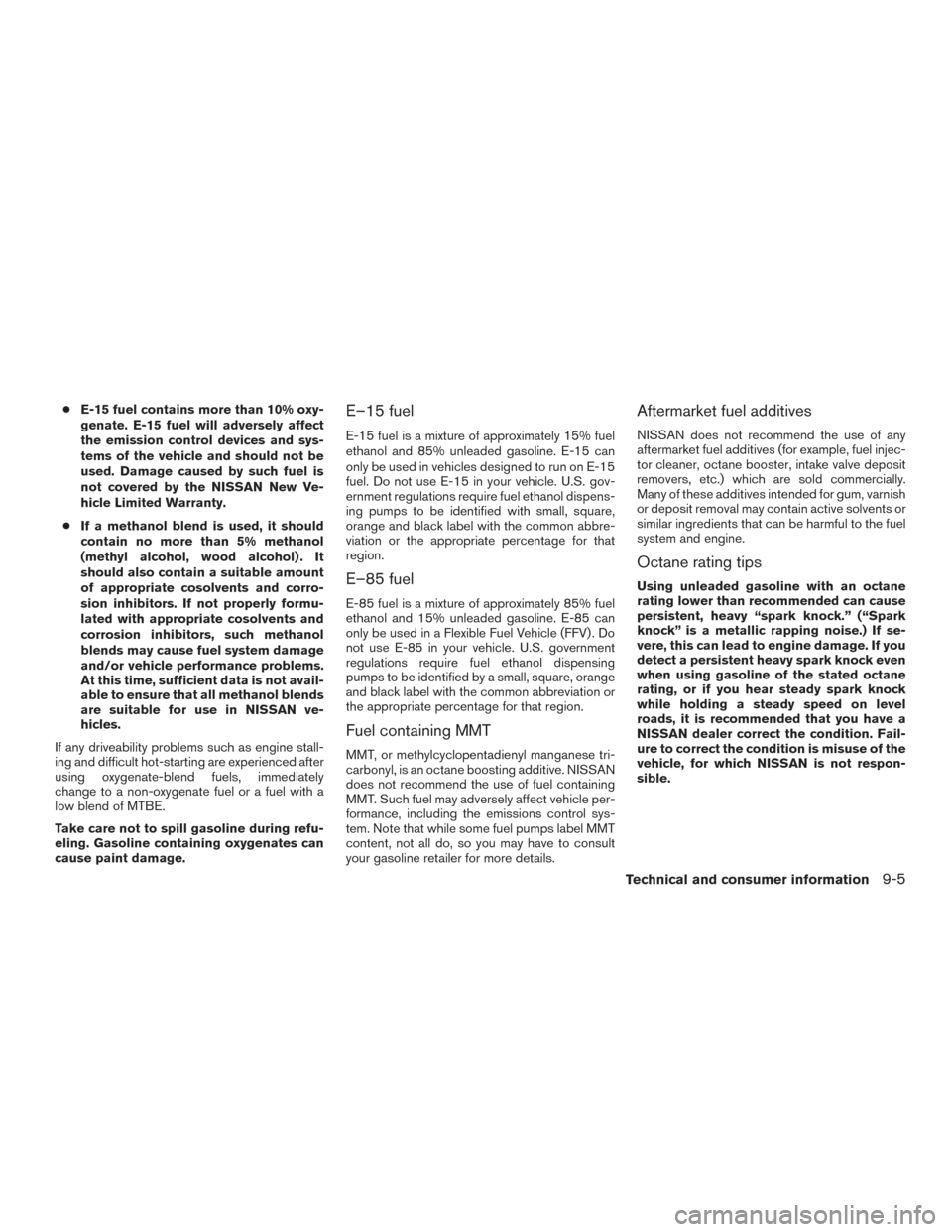
●E-15 fuel contains more than 10% oxy-
genate. E-15 fuel will adversely affect
the emission control devices and sys-
tems of the vehicle and should not be
used. Damage caused by such fuel is
not covered by the NISSAN New Ve-
hicle Limited Warranty.
● If a methanol blend is used, it should
contain no more than 5% methanol
(methyl alcohol, wood alcohol) . It
should also contain a suitable amount
of appropriate cosolvents and corro-
sion inhibitors. If not properly formu-
lated with appropriate cosolvents and
corrosion inhibitors, such methanol
blends may cause fuel system damage
and/or vehicle performance problems.
At this time, sufficient data is not avail-
able to ensure that all methanol blends
are suitable for use in NISSAN ve-
hicles.
If any driveability problems such as engine stall-
ing and difficult hot-starting are experienced after
using oxygenate-blend fuels, immediately
change to a non-oxygenate fuel or a fuel with a
low blend of MTBE.
Take care not to spill gasoline during refu-
eling. Gasoline containing oxygenates can
cause paint damage.E–15 fuel
E-15 fuel is a mixture of approximately 15% fuel
ethanol and 85% unleaded gasoline. E-15 can
only be used in vehicles designed to run on E-15
fuel. Do not use E-15 in your vehicle. U.S. gov-
ernment regulations require fuel ethanol dispens-
ing pumps to be identified with small, square,
orange and black label with the common abbre-
viation or the appropriate percentage for that
region.
E–85 fuel
E-85 fuel is a mixture of approximately 85% fuel
ethanol and 15% unleaded gasoline. E-85 can
only be used in a Flexible Fuel Vehicle (FFV) . Do
not use E-85 in your vehicle. U.S. government
regulations require fuel ethanol dispensing
pumps to be identified by a small, square, orange
and black label with the common abbreviation or
the appropriate percentage for that region.
Fuel containing MMT
MMT, or methylcyclopentadienyl manganese tri-
carbonyl, is an octane boosting additive. NISSAN
does not recommend the use of fuel containing
MMT. Such fuel may adversely affect vehicle per-
formance, including the emissions control sys-
tem. Note that while some fuel pumps label MMT
content, not all do, so you may have to consult
your gasoline retailer for more details.
Aftermarket fuel additives
NISSAN does not recommend the use of any
aftermarket fuel additives (for example, fuel injec-
tor cleaner, octane booster, intake valve deposit
removers, etc.) which are sold commercially.
Many of these additives intended for gum, varnish
or deposit removal may contain active solvents or
similar ingredients that can be harmful to the fuel
system and engine.
Octane rating tips
Using unleaded gasoline with an octane
rating lower than recommended can cause
persistent, heavy “spark knock.” (“Spark
knock” is a metallic rapping noise.) If se-
vere, this can lead to engine damage. If you
detect a persistent heavy spark knock even
when using gasoline of the stated octane
rating, or if you hear steady spark knock
while holding a steady speed on level
roads, it is recommended that you have a
NISSAN dealer correct the condition. Fail-
ure to correct the condition is misuse of the
vehicle, for which NISSAN is not respon-
sible.
Technical and consumer information9-5
Page 500 of 540
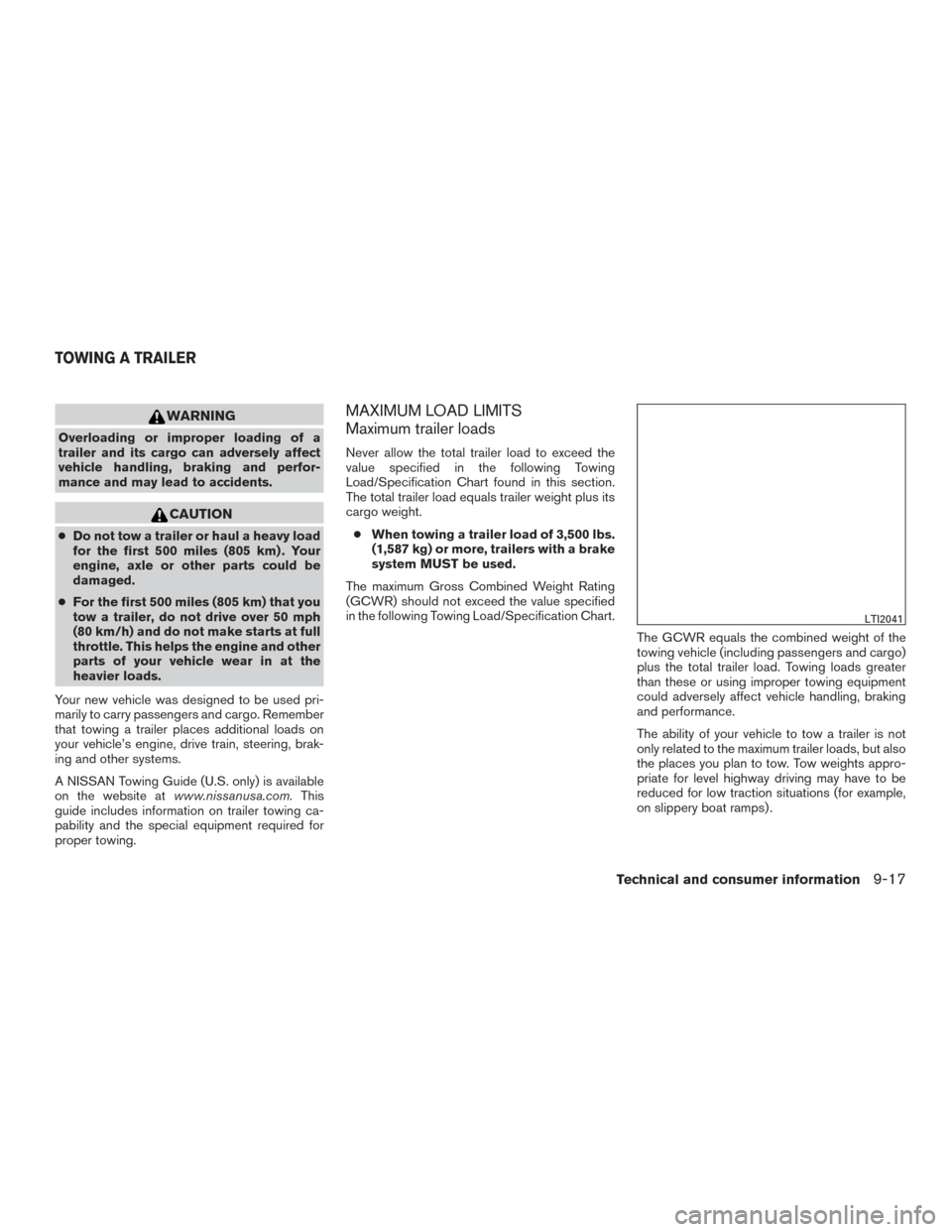
WARNING
Overloading or improper loading of a
trailer and its cargo can adversely affect
vehicle handling, braking and perfor-
mance and may lead to accidents.
CAUTION
●Do not tow a trailer or haul a heavy load
for the first 500 miles (805 km) . Your
engine, axle or other parts could be
damaged.
● For the first 500 miles (805 km) that you
tow a trailer, do not drive over 50 mph
(80 km/h) and do not make starts at full
throttle. This helps the engine and other
parts of your vehicle wear in at the
heavier loads.
Your new vehicle was designed to be used pri-
marily to carry passengers and cargo. Remember
that towing a trailer places additional loads on
your vehicle’s engine, drive train, steering, brak-
ing and other systems.
A NISSAN Towing Guide (U.S. only) is available
on the website at www.nissanusa.com. This
guide includes information on trailer towing ca-
pability and the special equipment required for
proper towing.
MAXIMUM LOAD LIMITS
Maximum trailer loads
Never allow the total trailer load to exceed the
value specified in the following Towing
Load/Specification Chart found in this section.
The total trailer load equals trailer weight plus its
cargo weight.
● When towing a trailer load of 3,500 lbs.
(1,587 kg) or more, trailers with a brake
system MUST be used.
The maximum Gross Combined Weight Rating
(GCWR) should not exceed the value specified
in the following Towing Load/Specification Chart. The GCWR equals the combined weight of the
towing vehicle (including passengers and cargo)
plus the total trailer load. Towing loads greater
than these or using improper towing equipment
could adversely affect vehicle handling, braking
and performance.
The ability of your vehicle to tow a trailer is not
only related to the maximum trailer loads, but also
the places you plan to tow. Tow weights appro-
priate for level highway driving may have to be
reduced for low traction situations (for example,
on slippery boat ramps) .
LTI2041
TOWING A TRAILER
Technical and consumer information9-17
Page 509 of 540
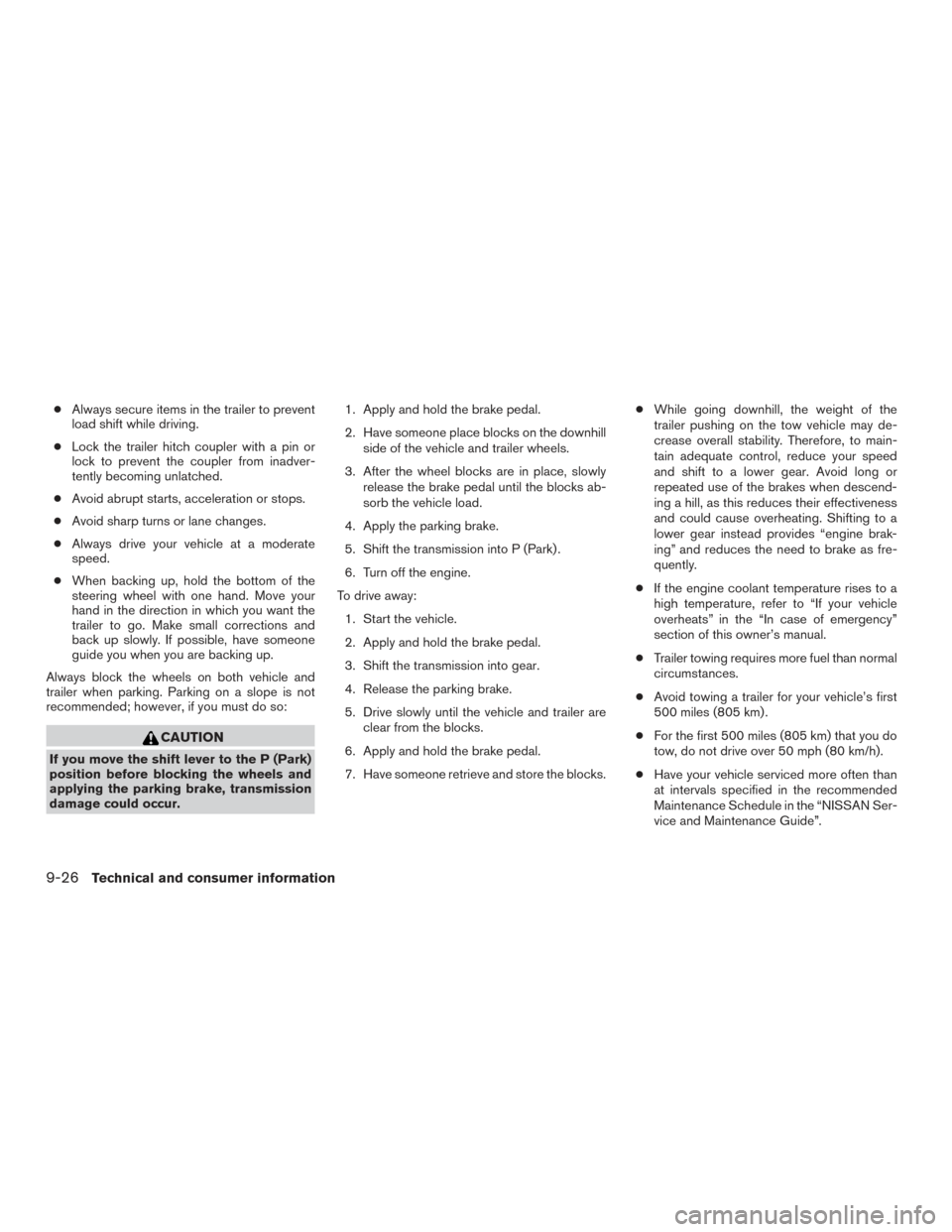
●Always secure items in the trailer to prevent
load shift while driving.
● Lock the trailer hitch coupler with a pin or
lock to prevent the coupler from inadver-
tently becoming unlatched.
● Avoid abrupt starts, acceleration or stops.
● Avoid sharp turns or lane changes.
● Always drive your vehicle at a moderate
speed.
● When backing up, hold the bottom of the
steering wheel with one hand. Move your
hand in the direction in which you want the
trailer to go. Make small corrections and
back up slowly. If possible, have someone
guide you when you are backing up.
Always block the wheels on both vehicle and
trailer when parking. Parking on a slope is not
recommended; however, if you must do so:
CAUTION
If you move the shift lever to the P (Park)
position before blocking the wheels and
applying the parking brake, transmission
damage could occur. 1. Apply and hold the brake pedal.
2. Have someone place blocks on the downhill
side of the vehicle and trailer wheels.
3. After the wheel blocks are in place, slowly release the brake pedal until the blocks ab-
sorb the vehicle load.
4. Apply the parking brake.
5. Shift the transmission into P (Park) .
6. Turn off the engine.
To drive away: 1. Start the vehicle.
2. Apply and hold the brake pedal.
3. Shift the transmission into gear.
4. Release the parking brake.
5. Drive slowly until the vehicle and trailer are clear from the blocks.
6. Apply and hold the brake pedal.
7. Have someone retrieve and store the blocks. ●
While going downhill, the weight of the
trailer pushing on the tow vehicle may de-
crease overall stability. Therefore, to main-
tain adequate control, reduce your speed
and shift to a lower gear. Avoid long or
repeated use of the brakes when descend-
ing a hill, as this reduces their effectiveness
and could cause overheating. Shifting to a
lower gear instead provides “engine brak-
ing” and reduces the need to brake as fre-
quently.
● If the engine coolant temperature rises to a
high temperature, refer to “If your vehicle
overheats” in the “In case of emergency”
section of this owner’s manual.
● Trailer towing requires more fuel than normal
circumstances.
● Avoid towing a trailer for your vehicle’s first
500 miles (805 km) .
● For the first 500 miles (805 km) that you do
tow, do not drive over 50 mph (80 km/h).
● Have your vehicle serviced more often than
at intervals specified in the recommended
Maintenance Schedule in the “NISSAN Ser-
vice and Maintenance Guide”.
9-26Technical and consumer information
Page 514 of 540
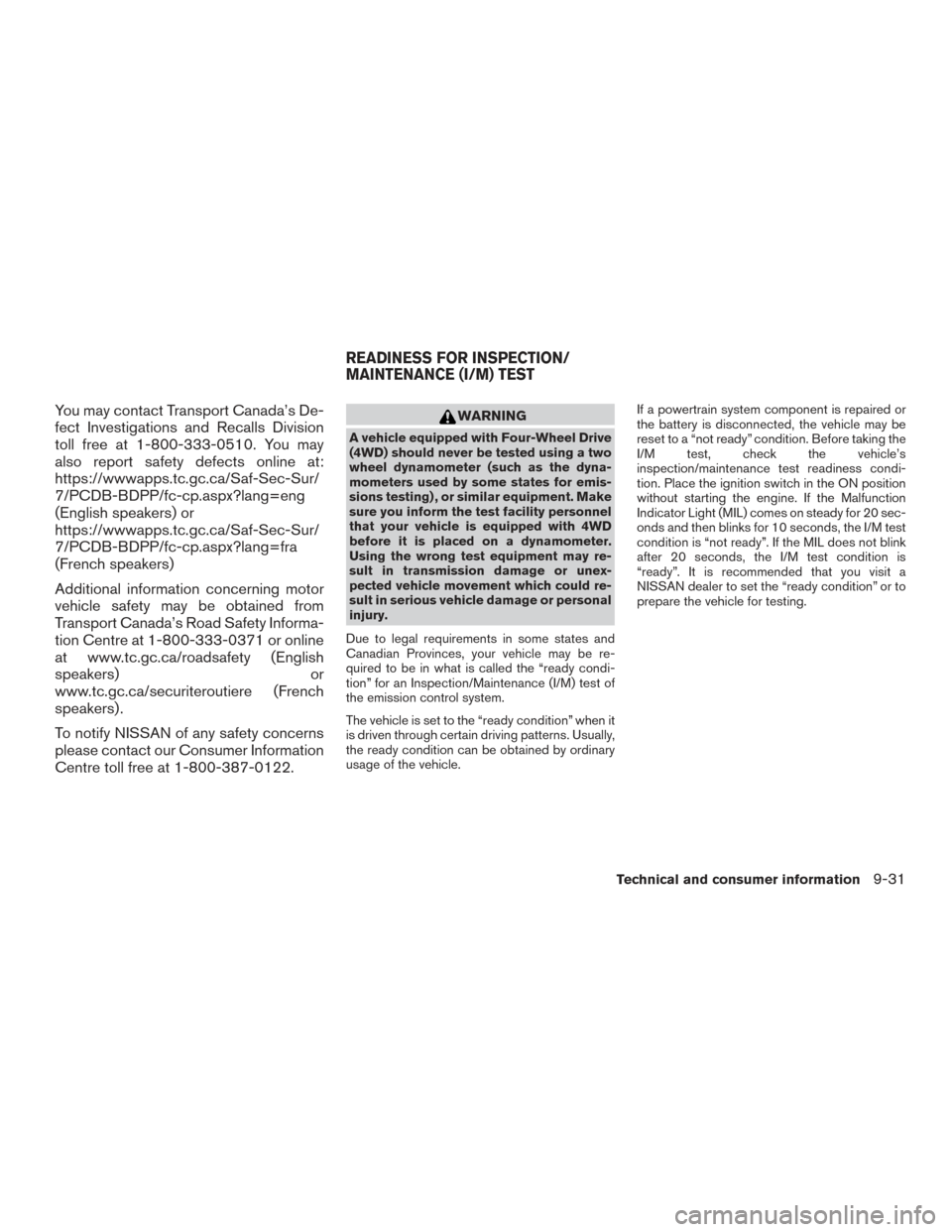
You may contact Transport Canada’s De-
fect Investigations and Recalls Division
toll free at 1-800-333-0510. You may
also report safety defects online at:
https://wwwapps.tc.gc.ca/Saf-Sec-Sur/
7/PCDB-BDPP/fc-cp.aspx?lang=eng
(English speakers) or
https://wwwapps.tc.gc.ca/Saf-Sec-Sur/
7/PCDB-BDPP/fc-cp.aspx?lang=fra
(French speakers)
Additional information concerning motor
vehicle safety may be obtained from
Transport Canada’s Road Safety Informa-
tion Centre at 1-800-333-0371 or online
at www.tc.gc.ca/roadsafety (English
speakers) or
www.tc.gc.ca/securiteroutiere (French
speakers) .
To notify NISSAN of any safety concerns
please contact our Consumer Information
Centre toll free at 1-800-387-0122.WARNING
A vehicle equipped with Four-Wheel Drive
(4WD) should never be tested using a two
wheel dynamometer (such as the dyna-
mometers used by some states for emis-
sions testing) , or similar equipment. Make
sure you inform the test facility personnel
that your vehicle is equipped with 4WD
before it is placed on a dynamometer.
Using the wrong test equipment may re-
sult in transmission damage or unex-
pected vehicle movement which could re-
sult in serious vehicle damage or personal
injury.
Due to legal requirements in some states and
Canadian Provinces, your vehicle may be re-
quired to be in what is called the “ready condi-
tion” for an Inspection/Maintenance (I/M) test of
the emission control system.
The vehicle is set to the “ready condition” when it
is driven through certain driving patterns. Usually,
the ready condition can be obtained by ordinary
usage of the vehicle. If a powertrain system component is repaired or
the battery is disconnected, the vehicle may be
reset to a “not ready” condition. Before taking the
I/M test, check the vehicle’s
inspection/maintenance test readiness condi-
tion. Place the ignition switch in the ON position
without starting the engine. If the Malfunction
Indicator Light (MIL) comes on steady for 20 sec-
onds and then blinks for 10 seconds, the I/M test
condition is “not ready”. If the MIL does not blink
after 20 seconds, the I/M test condition is
“ready”. It is recommended that you visit a
NISSAN dealer to set the “ready condition” or to
prepare the vehicle for testing.
READINESS FOR INSPECTION/
MAINTENANCE (I/M) TEST
Technical and consumer information9-31
Page 516 of 540
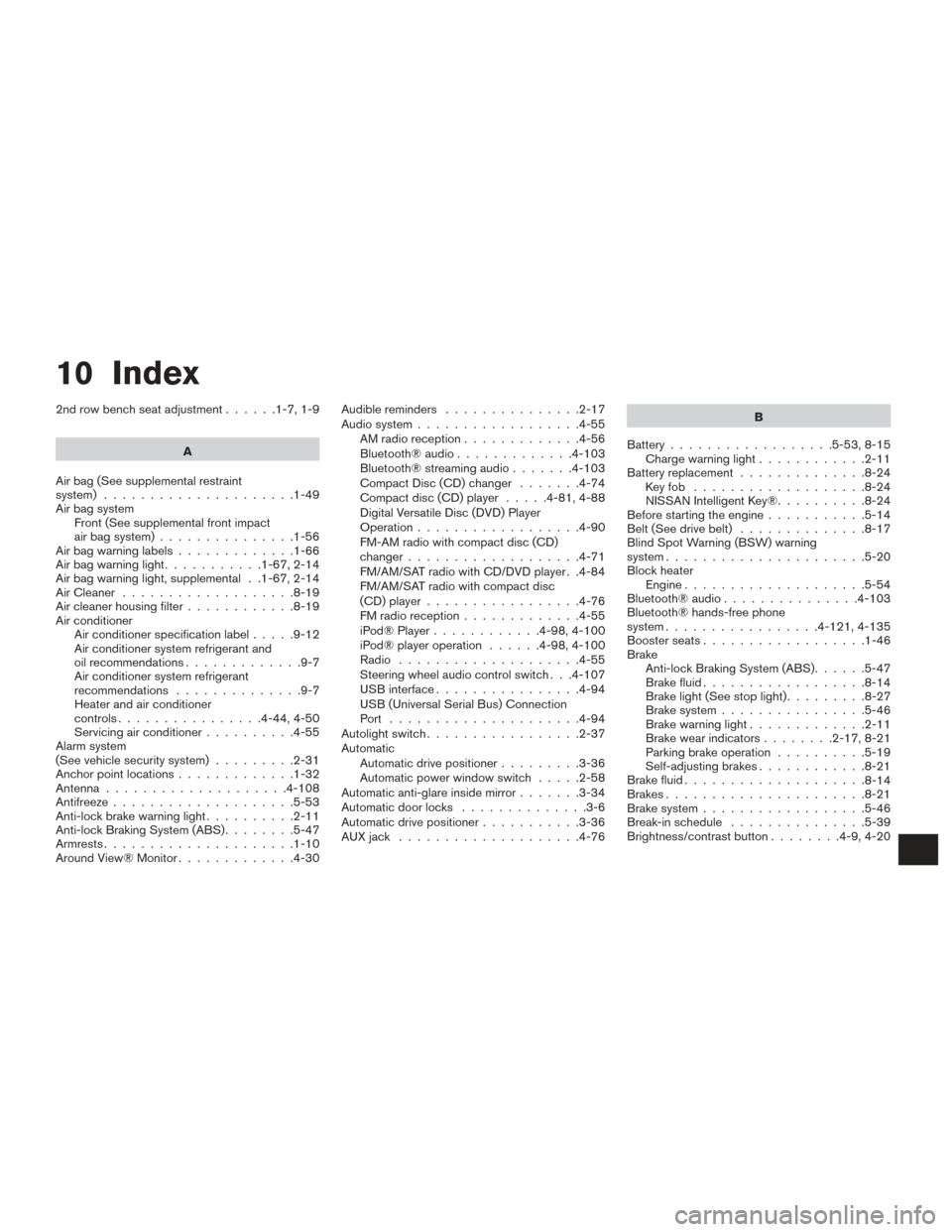
10 Index
2nd row bench seat adjustment......1-7,1-9
A
Air bag (See supplemental restraint
system) .....................1-49
Air bag system Front (See supplemental front impact
air bag system) ...............1-56
Airbagwarninglabels.............1-66
Airbagwarninglight...........1-67,2-14
Air bag warning light, supplemental . .1-67, 2-14
AirCleaner ...................8-19
Air cleaner housing filter ............8-19
Air conditioner Air conditioner specification label .....9-12
Air conditioner system refrigerant and
oil recommendations .............9-7
Air conditioner system refrigerant
recommendations ..............9-7
Heater and air conditioner
controls................4-44,4-50
Servicing air conditioner ..........4-55
Alarm system
(See vehicle security system) .........2-31
Anchor point locations .............1-32
Antenna ....................4-108
Antifreeze ....................5-53
Anti-lock brake warning light ..........2-11
Anti-lock Braking System (ABS) ........5-47
Armrests.....................1-10
Around View® Monitor .............4-30 Audible reminders
...............2-17
Audio system ..................4-55
AMradioreception.............4-56
Bluetooth®audio.............4-103
Bluetooth® streaming audio .......4-103
Compact Disc (CD) changer .......4-74
Compact disc (CD) player .....4-81,4-88
Digital Versatile Disc (DVD) Player
Operation ..................4-90
FM-AM radio with compact disc (CD)
changer ...................4-71
FM/AM/SAT radio with CD/DVD player . .4-84
FM/AM/SAT radio with compact disc
(CD) player .................4-76
FMradioreception.............4-55
iPod® Player ............4-98,4-100
iPod® player operation ......4-98,4-100
Radio ....................4-55
Steering wheel audio control switch . . .4-107
USB interface ................4-94
USB (Universal Serial Bus) Connection
Port .....................4-94
Autolight switch .................2-37
Automatic Automatic drive positioner .........3-36
Automatic power window switch .....2-58
Automatic anti-glare inside mirror .......3-34
Automatic door locks ..............3-6
Automatic drive positioner ...........3-36
AUXjack ....................4-76 B
Battery ..................5-53, 8-15
Charge warning light ............2-11
Battery replacement ..............8-24
Keyfob ...................8-24
NISSAN Intelligent Key® ..........8-24
Before starting the engine ...........5-14
Belt (See drive belt) ..............8-17
Blind Spot Warning (BSW) warning
system......................5-20
Block heater Engine ....................5-54
Bluetooth® audio ...............4-103
Bluetooth® hands-free phone
system.................4- 121, 4-135
Boosterseats..................1-46
Brake Anti-lock Braking System (ABS) ......5-47
Brake fluid ..................8-14
Brakelight(Seestoplight).........8-27
Brake system ................5-46
Brakewarninglight.............2-11
Brakewearindicators........2-17,8-21
Parking brake operation ..........5-19
Self-adjusting brakes ............8-21
Brake fluid ....................
8-14
Brakes ......................8-21
Brake system ..................5-46
Break-inschedule ...............5-39
Brightness/contrast button ........4-9,4-20
Page 517 of 540
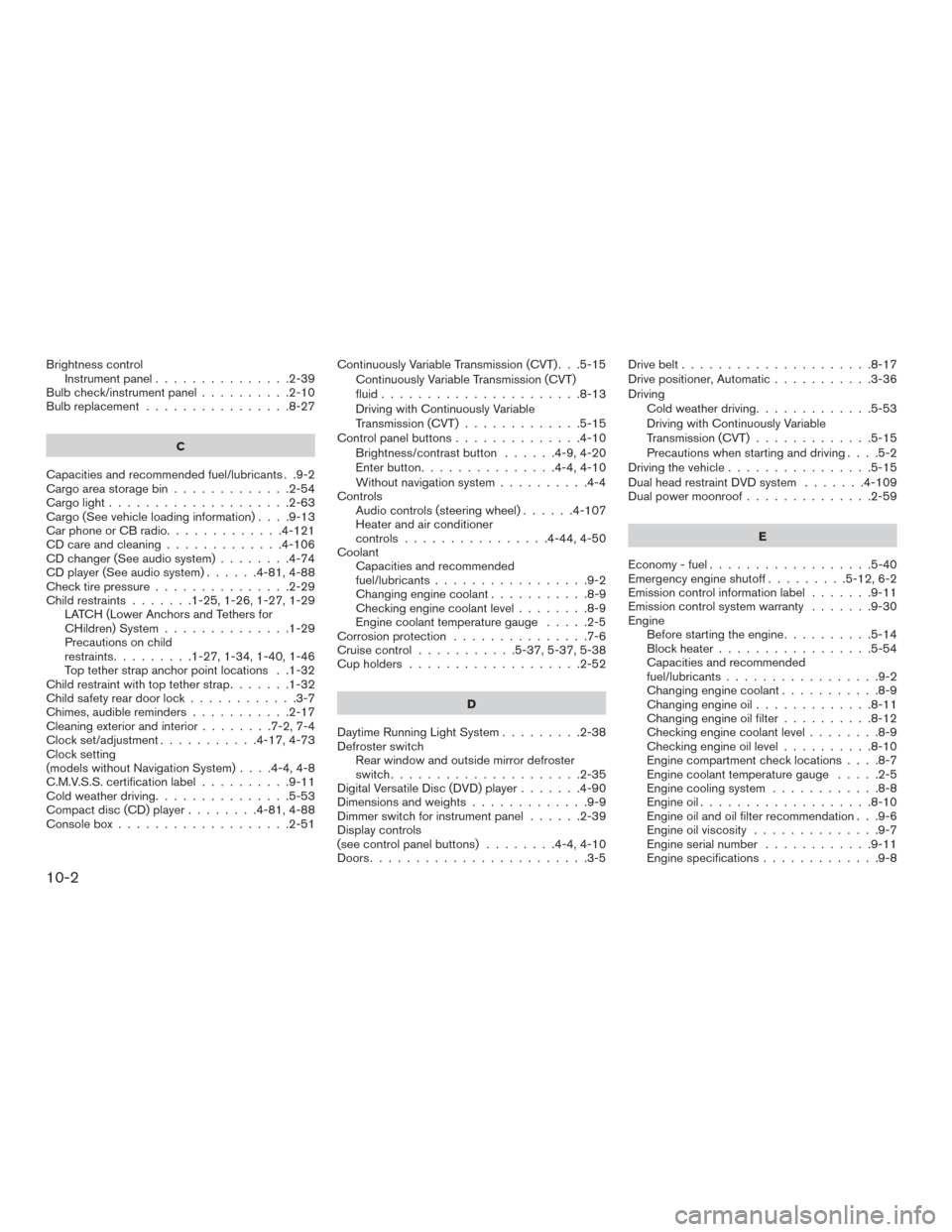
Brightness controlInstrument panel ...............2-39
Bulb check/instrument panel ..........2-10
Bulb replacement ................8-27
C
Capacities and recommended fuel/lubricants . .9-2
Cargoareastoragebin.............2-54
Cargolight....................2-63
Cargo(Seevehicleloadinginformation)....9-13
Car phone or CB radio .............4-121
CD care and cleaning .............4-106
CD changer (See audio system) ........4-74
CD player (See audio system) ......4-81,4-88
Check tire pressure ...............2-29
Child restraints .......1-25,1-26,1-27,1-29
LATCH (Lower Anchors and Tethers for
CHildren) System ..............1-29
Precautions on child
restraints.........1-27,1-34,1-40,1-46
Top tether strap anchor point locations . .1-32
Child restraint with top tether strap .......1-32
Child safety rear door lock ............3-7
Chimes, audible reminders ...........2-17
Cleaningexteriorandinterior........7-2,7-4
Clock set/adjustment ...........4-17,4-73
Clock setting
(models without Navigation System) ....4-4,4-8
C.M.V.S.S. certification label ..........9-11
Cold weather driving ...............5-53
Compact disc (CD) player ........4-81,4-88
Consolebox...................2-51 Continuously Variable Transmission (CVT) . . .5-15
Continuously Variable Transmission (CVT)
fluid......................8-13
Driving with Continuously Variable
Transmission (CVT) .............5-15
Control panel buttons ..............4-10
Brightness/contrast button ......4-9,4-20
Enterbutton...............4-4,4-10
Without navigation system ..........4-4
Controls Audio controls (steering wheel) ......4-107
Heater and air conditioner
controls................4-44,4-50
Coolant Capacities and recommended
fuel/lubricants .................9-2
Changingenginecoolant...........8-9
Checking engine coolant level ........8-9
Engine coolant temperature gauge .....2-5
Corrosion protection ...............7-6
Cruisecontrol ...........5-37,5-37,5-38
Cupholders...................2-52
D
Daytime Running Light System .........2-38
Defroster switch Rear window and outside mirror defroster
switch.....................2-35
Digital Versatile Disc (DVD) player .......4-90
Dimensionsandweights.............9-9
Dimmer switch for instrument panel ......2-39
Display controls
(seecontrolpanelbuttons) ........4-4,4-10
Doors ........................3-5 Drive belt
.....................8-17
Drive positioner, Automatic ...........3-36
Driving Cold weather driving .............5-53
Driving with Continuously Variable
Transmission (CVT) .............5-15
Precautions when starting and driving ....5-2
Driving the vehicle ................5-15
Dual head restraint DVD system .......4-109
Dual power moonroof ..............2-59
E
Economy-fuel..................5-40
Emergency engine shutoff .........5-12,6-2
Emission control information label .......9-11
Emission control system warranty .......9-30
Engine Before starting the engine ..........
5-14
Blockheater.................5-54
Capacities and recommended
fuel/lubricants.................9-2
Changing engine coolant ...........8-9
Changingengineoil.............8-11
Changing engine oil filter ..........8-12
Checking engine coolant level ........8-9
Checking engine oil level ..........8-10
Engine compartment check locations ....8-7
Engine coolant temperature gauge .....2-5
Engine cooling system ............8-8
Engineoil...................8-10
Engine oil and oil filter recommendation . . .9-6
Engine oil viscosity ..............9-7
Engine serial number ............9-11
Engine specifications .............9-8
10-2
Page 518 of 540
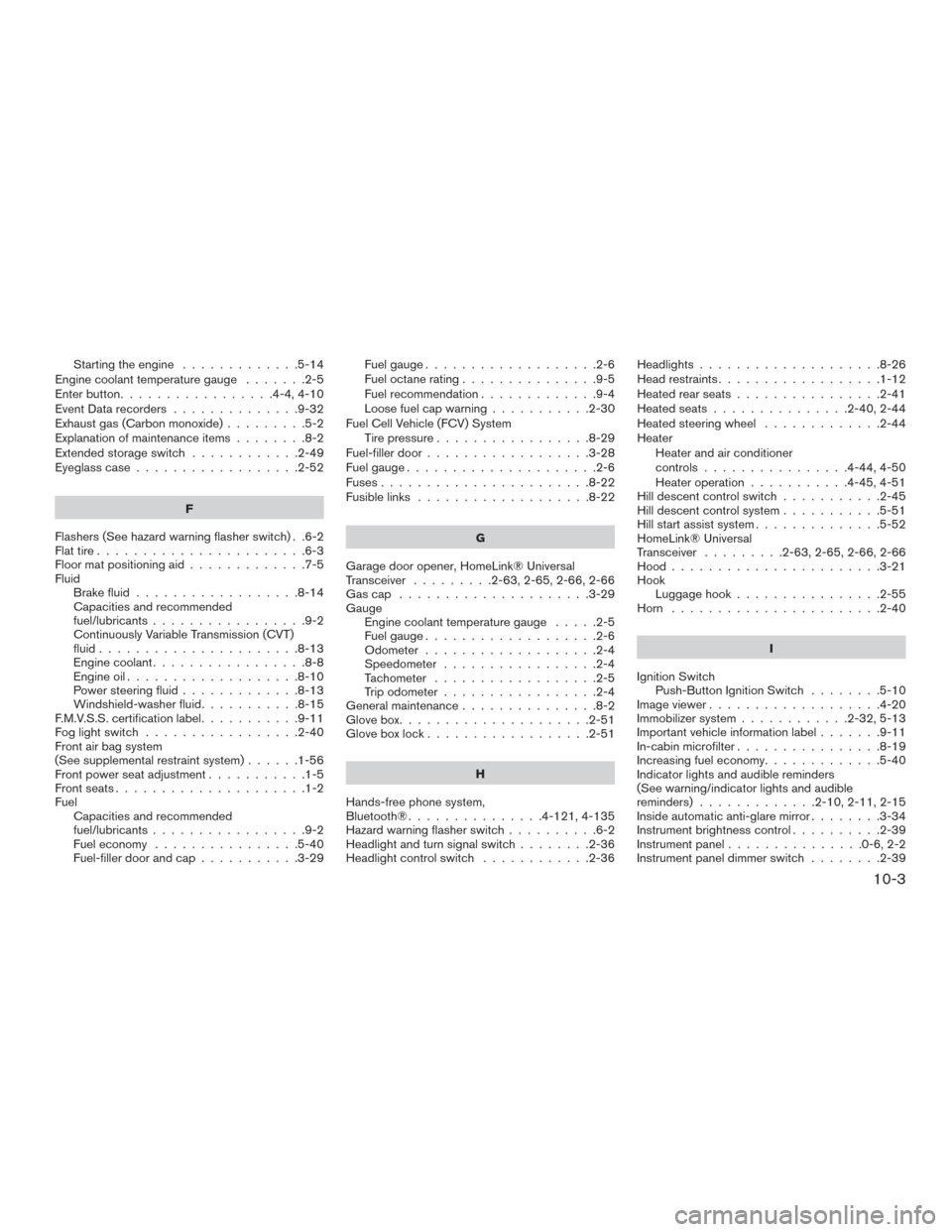
Starting the engine.............5-14
Engine coolant temperature gauge .......2-5
Enterbutton.................4-4,4-10
Event Data recorders ..............9-32
Exhaust gas (Carbon monoxide) .........5-2
Explanation of maintenance items ........8-2
Extendedstorageswitch ............2-49
Eyeglass case ..................2-52
F
Flashers (See hazard warning flasher switch) . .6-2
Flat tire .......................6-3
Floor mat positioning aid .............7-5
Fluid Brake fluid ..................8-14
Capacities and recommended
fuel/lubricants .................9-2
Continuously Variable Transmission (CVT)
fluid......................8-13
Engine coolant .................8-8
Engine oil ...................8-10
Power steering fluid .............8-13
Windshield-washerfluid...........8-15
F.M.V.S.S. certification label ...........9-11
Foglightswitch .................2-40
Front air bag system
(See supplemental restraint system) ......1-56
Front power seat adjustment ...........1-5
Frontseats.....................1-2
Fuel Capacities and recommended
fuel/lubricants .................9-2
Fuel economy ................5-40
Fuel-filler door and cap ...........3-29 Fuel gauge
...................2-6
Fuel octane rating ...............9-5
Fuel recommendation .............9-4
Loose fuel cap warning ...........2-30
Fuel Cell Vehicle (FCV) System Tirepressure.................8-29
Fuel-filler door ..................3-28
Fuelgauge.....................2-6
Fuses.......................8-22
Fusiblelinks ...................8-22
G
Garage door opener, HomeLink® Universal
Transceiver .........2-63,2-65,2-66,2-66
Gascap .....................3-29
Gauge Engine coolant temperature gauge .....2-5
Fuel gauge ...................2-6
Odometer ...................2-4
Speedometer .................2-4
Tachometer ..................2-5
Trip odometer .................2-4
General maintenance ...............8-2
Glovebox.....................2-51
Gloveboxlock..................2-51
H
Hands-free phone system,
Bluetooth®...............4- 121, 4-135
Hazard warning flasher switch ..........6-2
Headlight and turn signal switch ........2-36
Headlight control switch ............2-36 Headlights....................8-26
Head restraints
..................1-12
Heated rear seats ................2-41
Heated seats ...............2-40,2-44
Heated steering wheel .............2-44
Heater Heater and air conditioner
controls ................4-44,4-50
Heater operation ...........4-45,4-51
Hill descent control switch ...........2-45
Hill
descent control system ...........5-51
Hill start assist system ..............5-52
HomeLink® Universal
Transceiver .........2-63,2-65,2-66,2-66
Hood.......................3-21
Hook Luggage hook ................2-55
Horn .......................2-40
I
Ignition Switch Push-Button Ignition Switch ........5-10
Imageviewer...................4-20
Immobilizer system ............2-32,5-13
Important vehicle information label .......9-11
In-cabin microfilter ................8-19
Increasing fuel economy .............5-40
Indicator lights and audible reminders
(See warning/indicator lights and audible
reminders).............2-10,2-11,2-15
Inside automatic anti-glare mirror ........3-34
Instrument brightness control ..........2-39
Instrumentpanel...............0-6,2-2
Instrument panel dimmer switch ........2-39
10-3
Page 519 of 540
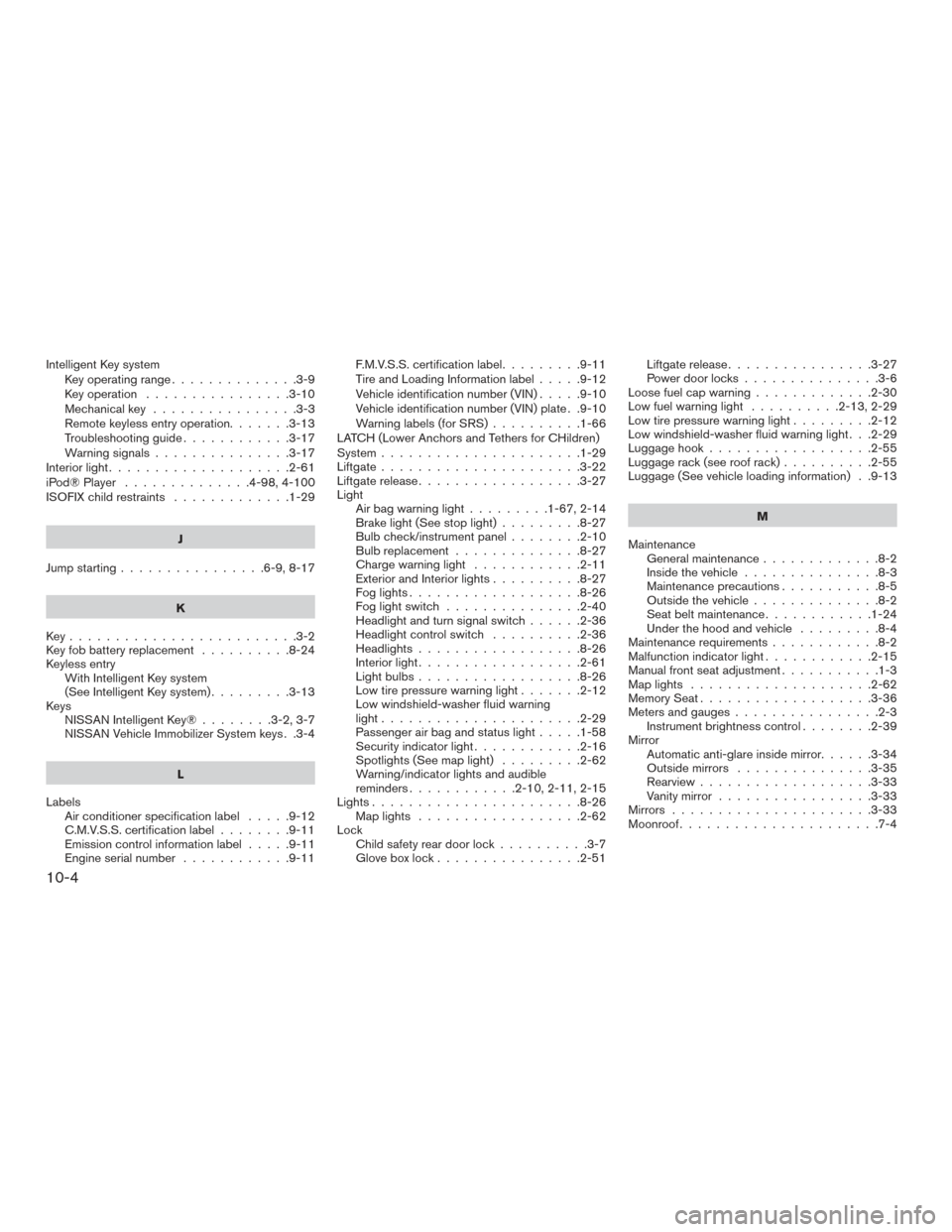
Intelligent Key systemKey operating range ..............3-9
Key operation ................3-10
Mechanicalkey ................3-3
Remote keyless entry operation.......3-13
Troubleshooting guide ............3-17
Warning signals ...............3-17
Interiorlight....................2-61
iPod®Player ..............4-98,4-100
ISOFIX child restraints .............1-29
J
Jump starting ................6-9,8-17
K
Key.........................3-2
Key fob battery replacement ..........8-24
Keyless entry With Intelligent Key system
(See Intelligent Key system) .........3-13
Keys NISSAN Intelligent Key® ........3-2,3-7
NISSAN Vehicle Immobilizer System keys . .3-4
L
Labels Air conditioner specification label .....9-12
C.M.V.S.S. certification label ........9-11
Emissioncontrolinformationlabel.....9-11
Engine serial number ............9-11 F.M.V.S.S. certification label
.........9-11
Tire and Loading Information label .....9-12
Vehicle identification number (VIN) .....9-10
Vehicle identification number (VIN) plate . .9-10
Warning labels (for SRS) ..........1-66
LATCH (Lower Anchors and Tethers for CHildren)
System ......................1-29
Liftgate ......................3-22
Liftgate release ..................3-27
Light Air bag warning light .........1-67,2-14
Brake light (See stop light) .........8-27
Bulb check/instrument panel ........2-10
Bulbreplacement..............8-27
Charge warning light ............2-11
Exterior and Interior lights ..........8-27
Foglights...................8-26
Foglightswitch ...............2-40
Headlight and turn signal switch ......2-36
Headlight control switch ..........2-36
Headlights..................8-26
Interiorlight..................2-61
Lightbulbs..................8-26
Low tire pressure warning light .......2-12
Low windshield-washer fluid warning
light......................2-29
Passenger air bag and status light .....1-58
Security indicator light ............2-16
Spotlights(Seemaplight) .........2-62
Warning/indicator lights and audible
reminders ............2-10,2-11,2-15
Lights.......................8-26 Maplights ..................2-62
Lock Child safety rear door lock ..........3-7
Gloveboxlock................2-51 Liftgate release
................3-27
Power door locks ...............3-6
Loose fuel cap warning .............2-30
Low fuel warning light ..........2-13,2-29
Low tire pressure warning light .........2-12
Low windshield-washer fluid warning light . . .2-29
Luggage hook ..................2-55
Luggage rack (see roof rack) ..........2-55
Luggage (See vehicle loading information) . .9-13
M
Maintenance General maintenance .............8-2
Insidethevehicle...............8-3
Maintenance precautions ...........8-5
Outside the vehicle ..............8-2
Seat
belt maintenance ............1-24
Under the hood and vehicle .........8-4
Maintenance requirements ............8-2
Malfunction indicator light ............2-15
Manual front seat adjustment ...........1-3
Maplights ....................2-62
Memory Seat ...................3-36
Meters and gauges ................2-3
Instrument brightness control ........2-39
Mirror Automatic anti-glare inside mirror ......3-34
Outside mirrors ...............3-35
Rearview ...................3-33
Vanity mirror .................3-33
Mirrors ......................3-33
Moonroof ......................7-4
10-4